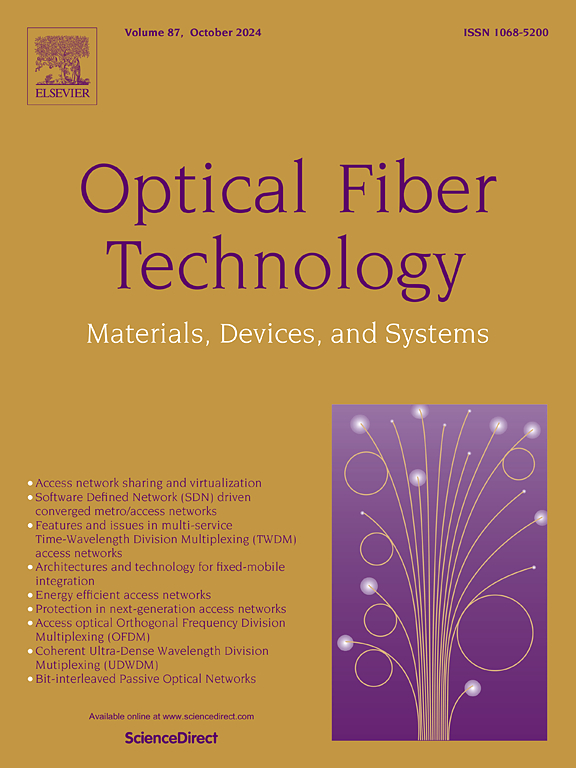用于量子应用的可编程脉冲宽度和波长可调掺铒有源锁模激光器
IF 2.7
3区 计算机科学
Q2 ENGINEERING, ELECTRICAL & ELECTRONIC
引用次数: 0
摘要
我们演示了脉冲调制的脉冲宽度和波长可调掺铒锁模激光器(PWT-MLL),而不是正弦调制。我们建立了一个基于离散耦合模式的理论模型,并进行了数值求解,以研究脉冲调制对我们所提出的PWT-MLL脉宽可调性的影响。我们还研究了腔内滤波器对激光器性能的影响。使用两种类型的光带通滤波器(obpf) -固定滤波器与3db带宽为0.7 nm和可调谐滤波器与3db带宽为0.25 nm -我们实现了在固定重复率的时间和波长可调性。在可调滤波器的情况下,激光的脉冲宽度可从2.3 ns调到370 ps,在固定滤波器的情况下,脉冲宽度可从700 ps调到91 ps。波长可以在整个c波段进行调谐。研究结果表明,脉冲调制占空比对超模噪声抑制比(SMSR)和信噪比(SNR)有显著影响。使用可调谐光纤布拉格光栅(TFBG),所有占空比的平均SMSR约为27 dB。相比之下,密集波分复用(DWDM)滤波器在急剧下降之前仅保持高SMSR至20%的占空比。在这两种配置下,平均信噪比都接近50 dB。本文章由计算机程序翻译,如有差异,请以英文原文为准。
Programmable pulse width and wavelength tunable Er-doped active mode-locked laser for quantum applications
We demonstrate pulse width and wavelength tunable Er-doped mode lock laser (PWT-MLL) using pulsed modulation as opposed to sinusoidal modulation. We develop a theoretical model based on discrete coupled modes and solve it numerically to study the effect of pulsed modulation on the pulse width tunability of our proposed PWT-MLL. We also study the impact of intra-cavity filter on the performance of our laser. Using two types of optical bandpass filters (OBPFs)—a fixed filter with a 3 dB bandwidth of 0.7 nm and a tunable filter with a 3 dB bandwidth of 0.25 nm—we achieve both temporal and wavelength tunability at a fixed repetition rate. The pulse width of the laser is tunable from 2.3 ns to 370 ps in the case of a tunable filter and from 700 ps to 91 ps in the case of a fixed filter. The wavelength can be tuned across the entire C-band. Our results demonstrate that supermode noise suppression ratio (SMSR) and signal-to-noise ratio (SNR) are significantly influenced by pulse modulation duty cycles. Using Tunable Fiber Bragg grating (TFBG), the average SMSR was approximately 27 dB across all duty cycles. In contrast, the Dense Wavelength Division Multiplexing (DWDM) filter maintained a high SMSR only down to a 20 % duty cycle before declining sharply. In both configurations, the average SNR was close to 50 dB.
求助全文
通过发布文献求助,成功后即可免费获取论文全文。
去求助
来源期刊

Optical Fiber Technology
工程技术-电信学
CiteScore
4.80
自引率
11.10%
发文量
327
审稿时长
63 days
期刊介绍:
Innovations in optical fiber technology are revolutionizing world communications. Newly developed fiber amplifiers allow for direct transmission of high-speed signals over transcontinental distances without the need for electronic regeneration. Optical fibers find new applications in data processing. The impact of fiber materials, devices, and systems on communications in the coming decades will create an abundance of primary literature and the need for up-to-date reviews.
Optical Fiber Technology: Materials, Devices, and Systems is a new cutting-edge journal designed to fill a need in this rapidly evolving field for speedy publication of regular length papers. Both theoretical and experimental papers on fiber materials, devices, and system performance evaluation and measurements are eligible, with emphasis on practical applications.
 求助内容:
求助内容: 应助结果提醒方式:
应助结果提醒方式:


